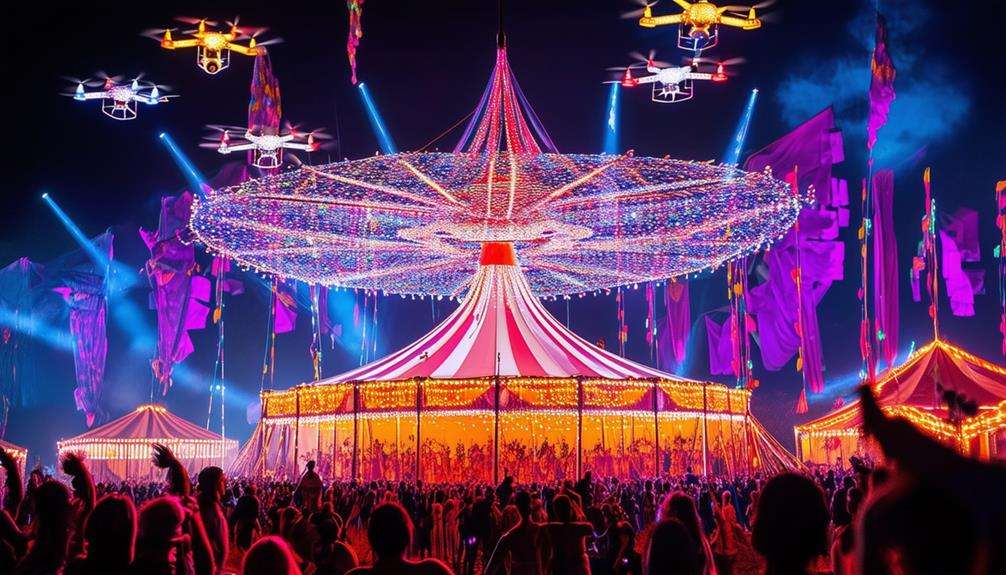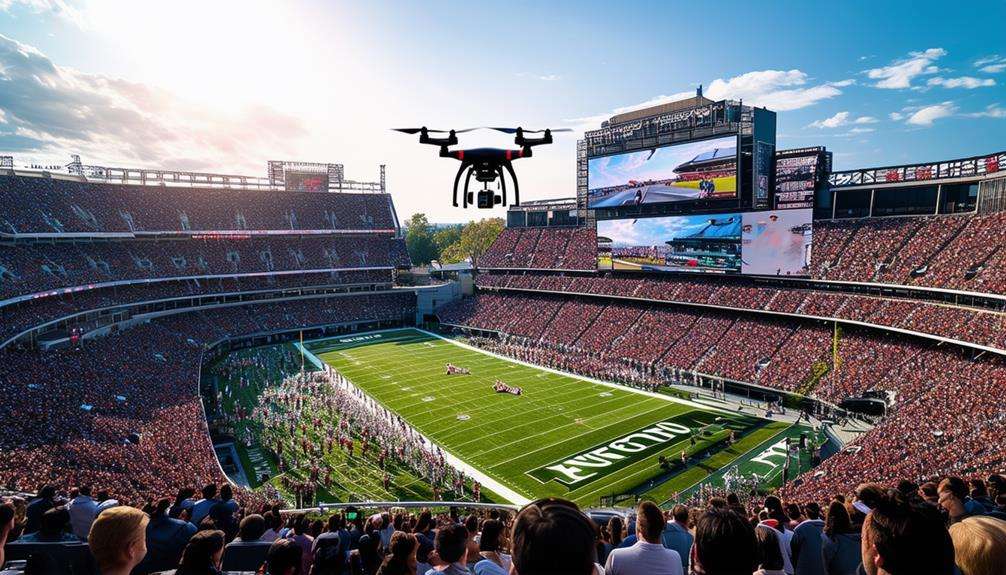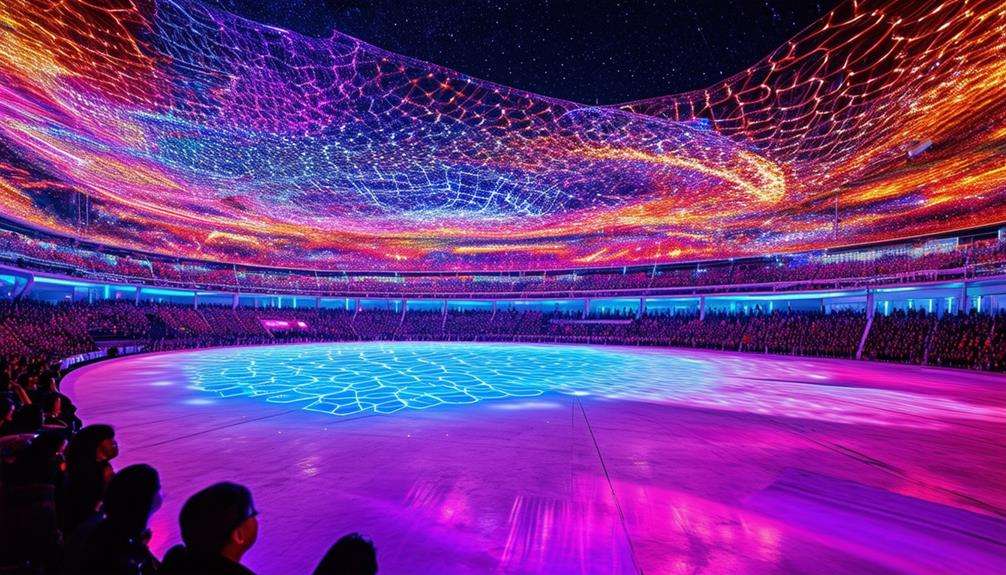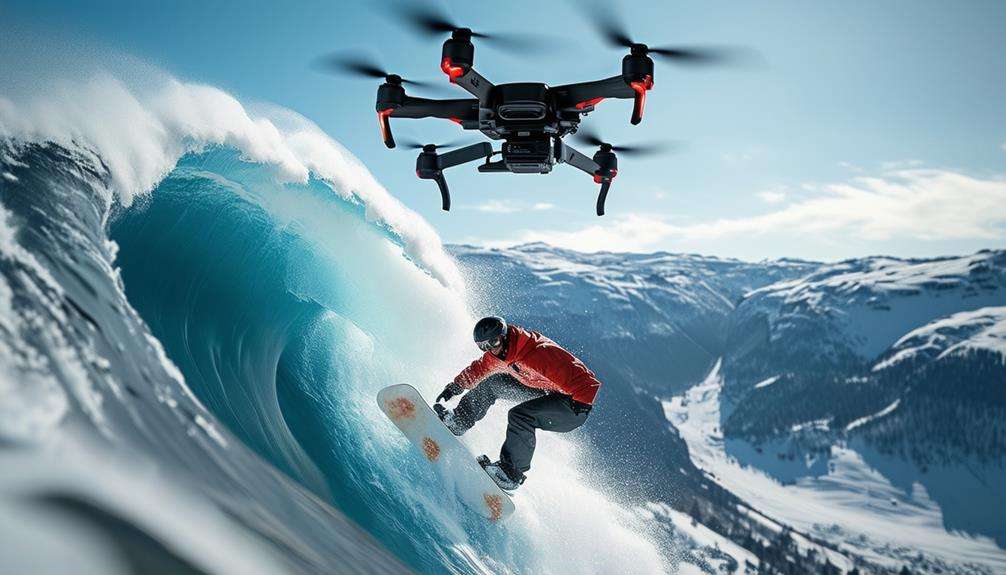How Drones Are Used to Film Extreme Sports
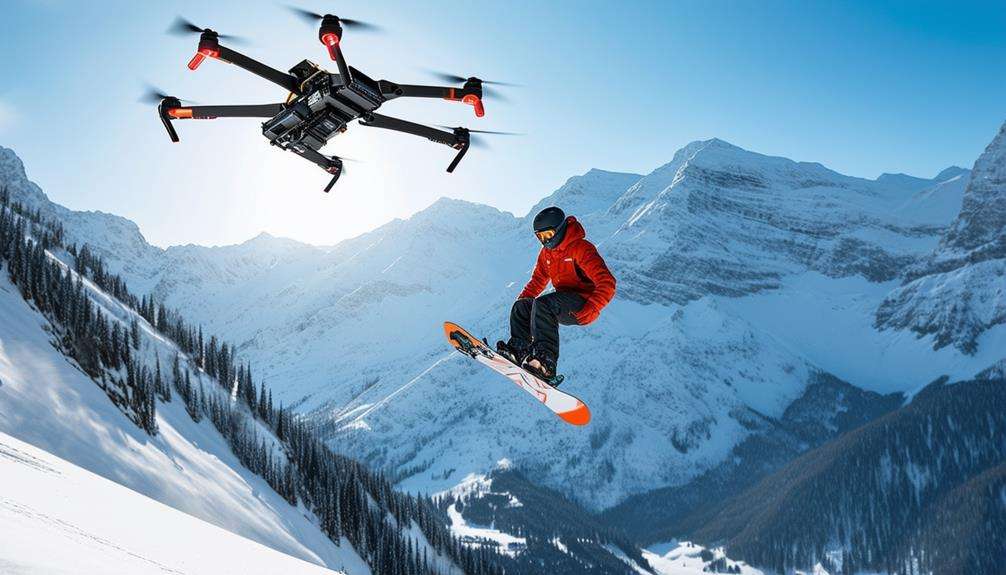
Imagine you're watching an extreme sports event, and the footage suddenly shifts to a breathtaking aerial view that follows the athlete's every twist and turn. This immersive experience is made possible by drones, which have revolutionized the filming of extreme sports.
Drones provide unique angles and smooth tracking shots that traditional cameras can't achieve. They are highly effective in capturing high-adrenaline moments thanks to their maneuverability and advanced stabilization technology.
However, operating drones in such dynamic environments presents challenges, including maintaining a stable signal, avoiding obstacles, and dealing with varying weather conditions. Let's delve into this fascinating intersection of technology and adrenaline.
Capturing Aerial Footage
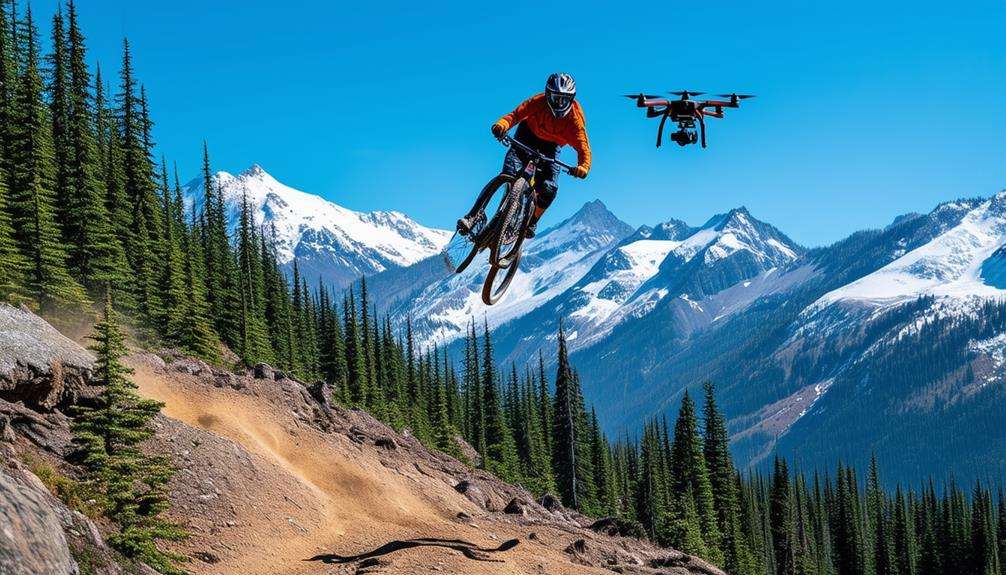
Drones provide dynamic aerial footage that captures the excitement and intensity of extreme sports. Whether snowboarding down a steep slope, surfing massive waves, or traversing a rugged mountain biking trail, drones offer unique angles and perspectives unattainable with traditional cameras. By capturing aerial footage, you can showcase the fast-paced action and adrenaline-filled moments that define these sports.
With their agility and maneuverability, drones can get close to athletes, offering smooth tracking shots and breathtaking close-ups. This capability allows viewers to see every twist, turn, and jump, highlighting the athletes' skills and techniques. The aerial perspective not only captures the broader landscape but also focuses on key moments, making the footage incredibly compelling.
Advancements in drone technology have made these devices essential for filming extreme sports. High-definition cameras, stabilization features, and improved battery life enable longer and higher-quality filming. Whether you're a professional filmmaker or an enthusiast, using drones for aerial footage transforms the visual experience, giving viewers a front-row seat to the action. Additionally, the immersive experience created by drone footage keeps audiences engaged and returning for more.
Following Athletes
Capturing athletes' movements with precision, drones offer dynamic angles that bring viewers closer to the action than ever before. Using drones to film extreme sports provides a bird's-eye view and tracks athletes through every twist, turn, and jump. Whether surfing massive waves, snowboarding down steep slopes, or mountain biking through rugged trails, drones offer an immersive experience.
Drones' ability to follow athletes closely during high-risk maneuvers showcases their skills and techniques with unparalleled clarity. This is beneficial not only for competitions but also for training sessions. Athletes and coaches can review the footage to analyze performances, make improvements, and develop new strategies. The detailed video footage highlights strengths and pinpoints areas for improvement, making training more effective.
Unique Angles
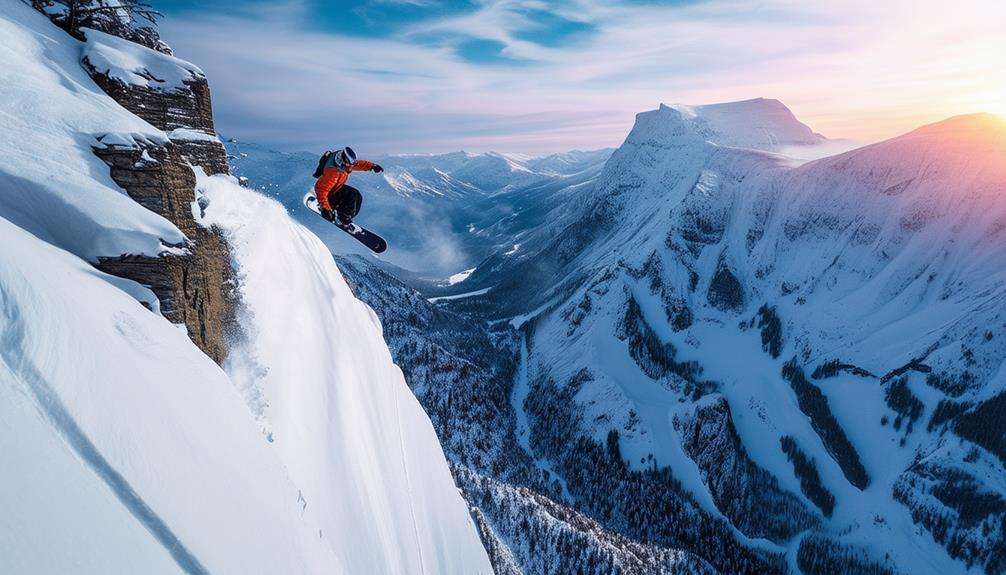
Experience extreme sports like never before with unique angles and dynamic perspectives. Drones capture video from vantage points that traditional cameras can't reach, offering breathtaking views and heart-stopping action shots that elevate the excitement of these sports.
Imagine watching a snowboarder carve down a mountain. A drone's bird's-eye view provides a sweeping panorama of the descent, showcasing the athlete's skill against a backdrop of snowy peaks. Or picture a surfer riding a massive wave. A drone can hover just above the crest, giving you an up-close look at the surfer's daring maneuvers.
Here are three dynamic angles drones can offer:
- Aerial Shots: Capture a panoramic view of the entire sports arena, showcasing the vast scope and beauty of the environment.
- Close-Up Action Shots: Focus on the athlete's intense expressions and precise movements, immersing you in the moment.
- Unique Perspectives: Fly through obstacles and challenging terrains, highlighting the speed and agility required for the sport.
These unique angles make drone footage a game-changer, presenting extreme sports in stunning, cinematic quality. You won't just watch the action; you'll feel like you're part of it.
Smooth Tracking Shots
When filming extreme sports, smooth tracking shots are vital for seamlessly capturing the action. Advanced stabilization technology ensures your drone's footage remains steady, even with fast-moving subjects. This enables dynamic movement capture and smooth transitions, providing viewers with an immersive experience.
Stabilized Aerial Footage
Drones deliver smooth tracking shots, making extreme sports videos more dynamic and immersive. Equipped with cameras and advanced stabilization technology, drones capture stunning aerial footage that remains steady even in fast-paced environments. Gyroscopic sensors and GPS work together to maintain precise and stable footage, enhancing the visual quality of your extreme sports videos.
Imagine watching a live video of a snowboarder racing down a mountain, with a drone effortlessly keeping pace and delivering smooth, cinematic shots. The stabilized aerial footage offers a breathtaking perspective, showcasing the speed and intensity of the athlete's movements. This not only highlights their skill but also immerses viewers, making them feel like part of the action.
Here's how stabilized aerial footage enhances your viewing experience:
- Smooth Transitions: The drone's stability technology ensures seamless transitions between shots, maintaining continuity and flow.
- Cinematic Quality: Advanced stabilization adds a professional, cinematic touch to extreme sports footage, enhancing production value.
- Engaged Viewer Interaction: Smooth, immersive shots captivate viewers, making them more likely to watch the entire video and share it with others.
Dynamic Movement Capture
Drones excel in capturing dynamic movements with smooth tracking shots, making them indispensable in filming extreme sports. The speed and agility of athletes are crucial, and drones provide aerial perspectives that highlight these aspects brilliantly. Imagine a snowboarder navigating a steep slope or a motocross rider tackling rough terrain; drones can follow these movements seamlessly, ensuring not a single exciting moment is missed.
Drone racing itself is an action sport that showcases the precision control of these devices. Pilots navigate drones through tight courses at high speeds, demonstrating their capabilities. This same technology is applied to track athletes through challenging terrains and obstacles, enhancing the viewer's experience. Whether it's a skateboarder performing intricate tricks or a mountain biker on a rugged trail, drones capture every detail with fluidity.
The ability to capture close-up shots and intricate maneuvers makes drones essential for filming extreme sports. Viewers get an up-close look at the intensity and skill of the athletes, making the footage more engaging and immersive. Smooth tracking shots bring you directly into the heart of the action, enhancing the overall viewing experience.
Seamless Transition Shots
Drones' smooth transition shots bring fluidity and excitement to extreme sports footage, making every twist and turn feel immersive. Ideal for high-speed action, drones excel at capturing seamless transitions, providing dynamic angles and perspectives that pull you into the thrill of the moment.
Their agility allows drones to follow athletes through fast-paced environments, ensuring no exciting movement is missed. The stability of their footage means you can clearly experience every maneuver, jump, and flip. Picture a snowboarder carving down a mountain, a mountain biker navigating a dense forest trail, or a surfer riding a colossal wave—all captured with fluid, uninterrupted shots that keep you on the edge of your seat.
Here's how drones enhance the experience:
- Dynamic Tracking: The drone closely follows the athlete, capturing every detail of their movement from multiple angles.
- Seamless Transitions: Smooth changes between shots maintain the flow and intensity of the action.
- Stable Footage: Advanced stabilization technology ensures clear and smooth footage, even during high-speed sequences.
Live Broadcasting
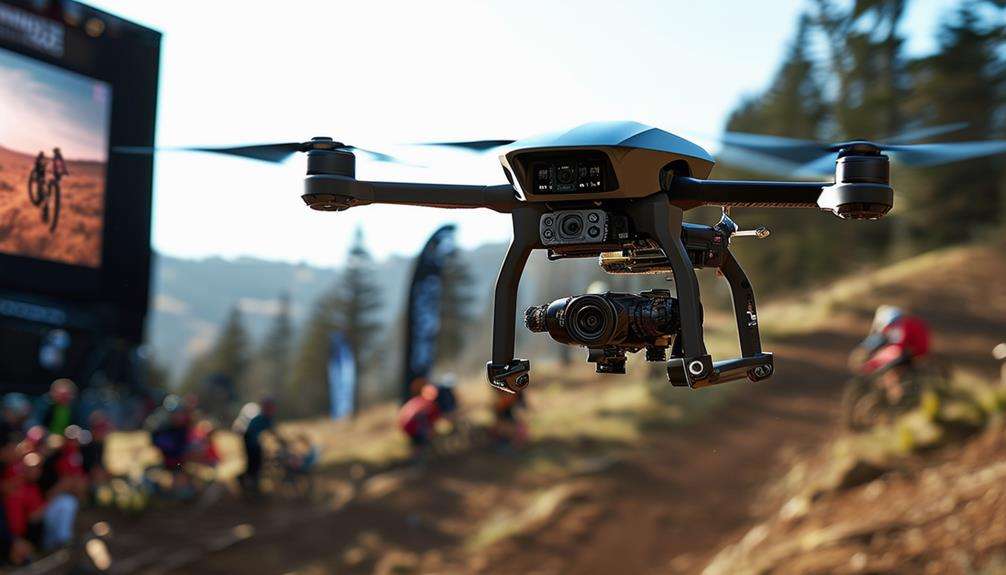
In live broadcasting, drones revolutionize the capture and presentation of extreme sports. Drone footage offers thrilling action shots and unique angles unattainable by traditional cameras. Picture a snowboarder carving down a mountain from an aerial perspective or a surfer riding a massive wave with every twist and turn captured by a drone. These dynamic views make the experience more immersive and exciting for the audience.
Drones' agility and maneuverability enable them to follow athletes through fast-paced and challenging terrains, ensuring no moment is missed. Whether it's a mountain biker on a rugged trail or a skateboarder performing tricks in an urban environment, drones provide continuous, fluid coverage. This real-time aerial footage adds a new dimension to live broadcasts, making viewers feel like they're in the middle of the action.
Slow-Motion Replays
Slow-motion replays captured by drones offer an unparalleled analysis of extreme sports, showcasing everything from an athlete's technique to the intensity of each moment. These replays provide a detailed view of the action, enabling appreciation of the intricate skills and split-second decisions that define these sports.
Drones facilitate slow-motion footage, transforming high-speed events into comprehensible sequences. Imagine watching a snowboarder execute a flawless trick on a half-pipe:
- Initial Takeoff: Observe the precise angle and power in the athlete's jump.
- Mid-Air Technique: Each twist, turn, and grab is highlighted, showcasing the athlete's control and agility.
- Landing Impact: Analyze the exact moment the board touches down, noting the balance and technique required for a successful landing.
High-quality slow-motion replays filmed by drones reveal the intensity and skill involved, making each moment more impactful. This advanced perspective allows for enhanced performance evaluation, aiding in training and competition analysis.
Weather Considerations
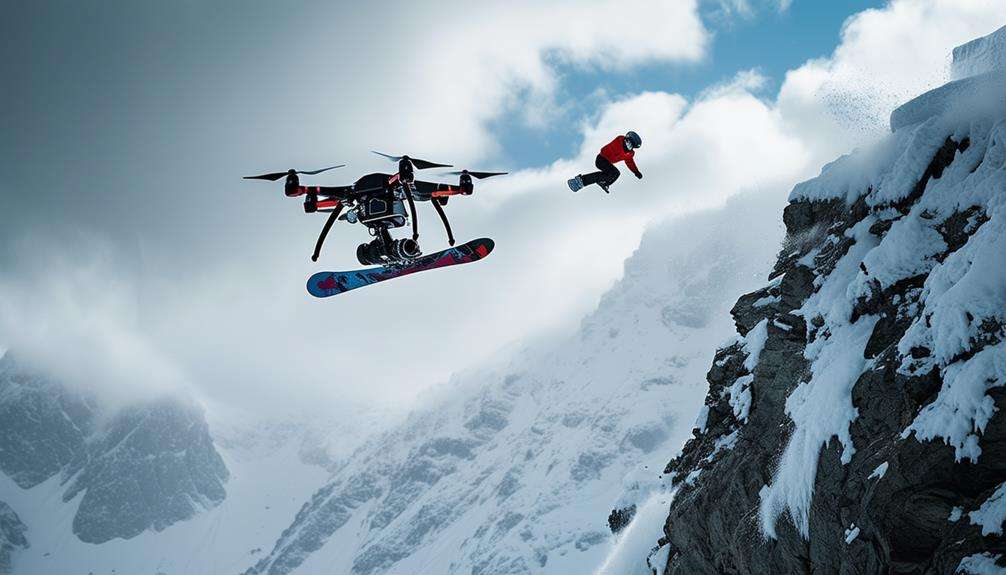
When filming extreme sports with drones, consider weather impacts like wind speed and temperature. Wind can disrupt your drone's stability, while temperature fluctuations can deplete battery life and affect performance. Monitoring these factors ensures safe and successful filming sessions.
Wind Speed Impact
The impact of wind speed on drone stability is a crucial consideration when filming extreme sports. Capturing high-adrenaline activities requires steady and smooth footage, but strong winds can significantly disrupt a drone's stability, making it difficult to control and achieve high-quality shots.
To illustrate the impact of wind speed on drone operations, consider these scenarios:
- Mountain Biking: Filming on rugged terrains where gusts can push your drone off course, complicating the task of tracking fast-moving cyclists.
- Surfing: Coastal winds can be unpredictable, affecting the drone's ability to hover steadily over the waves.
- Skydiving: High-altitude winds can dramatically shift the drone's position, making it challenging to capture free-falling athletes.
Constant monitoring of wind speed and direction is essential. High wind speeds may necessitate adjustments to your flight patterns and filming techniques to ensure both safety and footage quality.
Temperature Effects on Equipment
Extreme temperatures can significantly impact your drone's performance and reliability when filming extreme sports. Cold weather reduces battery efficiency, shortening flight times and potentially disrupting your filming schedule. As a drone pilot, always carry extra batteries to ensure continuous filming.
High temperatures introduce their own challenges, such as overheating components and sensors, which can lead to malfunctions at critical moments. To mitigate these issues, proper insulation and temperature regulation are crucial. Ensure your drone is equipped to handle the environmental extremes you'll encounter.
For example, insulate batteries in cold conditions and employ cooling mechanisms in hot weather to stabilize performance. Weather conditions like wind chill and humidity also play a significant role. Wind chill can worsen the effects of cold temperatures, while high humidity can impact flight stability and filming quality.
Adhering to safety regulations is essential to protect both your equipment and the quality of your footage. Proper preparation and awareness of these factors will help you capture the best possible shots in extreme sports environments.
Battery Management
Ensuring your drone's battery lasts throughout your extreme sports filming session is crucial for capturing uninterrupted, high-energy footage. Here are effective strategies to manage your drone's battery performance:
- Leverage Advanced Battery Management Systems: Modern drones are equipped with sophisticated battery management systems that optimize energy use by monitoring voltage, temperature, and overall battery health. These systems provide real-time data, enabling you to make informed decisions.
- Carry Spare Batteries: With drone battery life typically ranging from 15 to 30 minutes, depending on the model and conditions, having spare batteries is essential. This allows for quick swaps of depleted batteries, ensuring continuous filming without missing any action.
- Regularly Monitor Battery Levels: Extreme sports often take place in challenging conditions, such as cold temperatures, which can affect battery performance. Keep a close eye on battery levels throughout your session and replace batteries before they're completely drained to avoid mid-air shutdowns.
Legal Permits
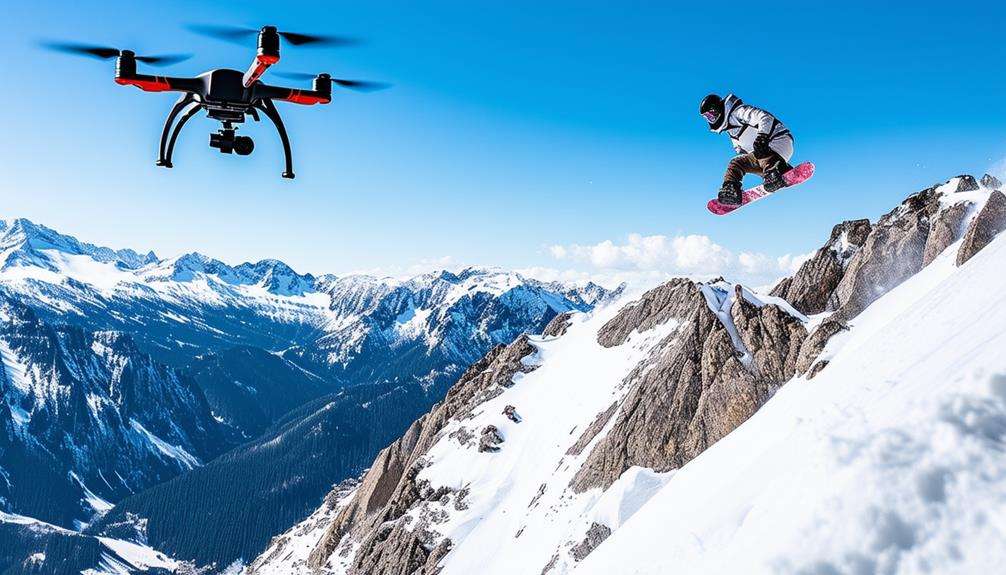
To film extreme sports using drones, you must obtain the necessary permits from relevant aviation authorities. Compliance with local regulations ensures your footage is legal and safe. Failure to secure these licenses can result in severe penalties, so make sure to obtain all required permits before you start filming.
Obtaining Filming Licenses
Before you can start filming extreme sports with drones, it's essential to secure the necessary legal permits and licenses from the relevant authorities. These permits ensure that your drone operations are safe and compliant with aviation regulations. Operating without these permits can result in legal repercussions and restrict your ability to film in specific areas.
Follow these three steps to obtain your filming licenses:
- Research Local Requirements: Investigate the specific aviation regulations in your intended filming area, as drone usage rules vary by country and region. Identify the authority that oversees drone operations and determine the required documentation.
- Apply for Permits: Begin the application process once you understand the requirements. This typically involves completing forms, detailing information about your drone, and describing your filming activities. Some regions may also necessitate proof of insurance or a safety plan.
- Await Approval: After submitting your application, you'll need to wait for approval. The processing time can vary, so plan accordingly. Upon approval, you'll receive your filming permits, authorizing you to proceed with your drone filming legally.
Compliance With Regulations
Securing the appropriate permits is just the first step; complying with all regulations governing drone use in extreme sports is crucial. Legal permits ensure that your drone operations align with aviation laws and safety guidelines. These permits must be obtained from relevant aviation authorities or regulatory bodies before filming any extreme sports event. Without them, you risk fines, penalties, or even more severe legal consequences for unauthorized drone use.
Legal permit requirements for drone filming in extreme sports can vary based on several factors, including the event's location, the type of extreme sport, and specific regulations governing aerial activities in that area. It's essential to research and understand these variables to ensure full compliance.
Adhering to legal permit requirements isn't just about avoiding trouble; it also demonstrates professionalism and responsibility. Following aviation laws and securing the necessary permits shows respect for the broader aviation community and the safety of athletes and spectators. While filming extreme sports with drones is exhilarating, doing it legally and safely should always be your top priority.
Equipment Recommendations
Investing in high-quality drones is essential for capturing stunning 4K footage of extreme sports. Models like the DJI Phantom 4 Pro and Mavic 2 Pro are renowned for their exceptional video quality, durability, and reliability in challenging environments.
For a smooth and safe filming experience, consider drones with obstacle avoidance sensors. The DJI Mavic Air 2 is an excellent choice, ensuring your drone can navigate unpredictable terrains without crashing. This feature is crucial for capturing high-speed action in rugged locations.
Additionally, drones compatible with popular action cameras enhance your filming versatility. The GoPro Karma drone, for example, pairs seamlessly with GoPro cameras, allowing you to capture heart-pounding moments from multiple angles.
Key features to look for in drones include:
- Obstacle Avoidance Sensors: Ensure safe and smooth operation in challenging environments.
- Long Battery Life: The Autel Robotics Evo II offers extended filming sessions in remote locations.
- Advanced Stabilization: The Yuneec Typhoon H Pro provides smooth footage during fast-paced extreme sports.
Conclusion
Drones have revolutionized extreme sports filming by capturing stunning aerial footage, closely following athletes, and offering unique perspectives. They enable smooth tracking shots and real-time broadcasting, creating an immersive viewing experience.
However, it's crucial to consider weather conditions and manage battery life effectively. Securing the necessary legal permits is also essential, and choosing the right equipment can significantly impact the quality of your footage. Embrace drone technology to elevate your extreme sports films and captivate your audience like never before!

